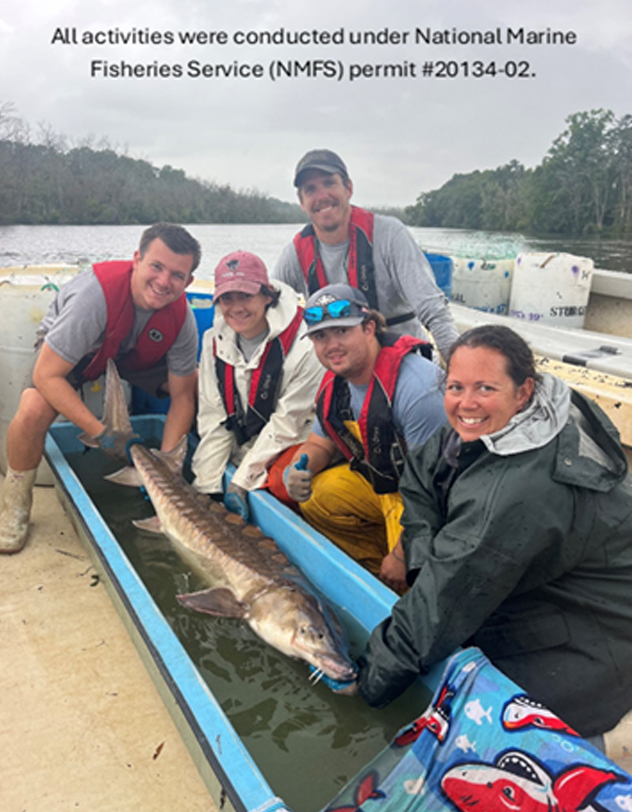
Atlantic Sturgeon in Maryland
Atlantic sturgeon,
Acipenser oxyrinchus oxyrinchus, are long-lived, estuarine dependent,
anadromous fish. They were an important species targeted by early settlers in the Chesapeake Bay (Hildebrand and Schroeder 1928). Landings were reported to be approximately 300,000-400,000 kg (661,000-882,000lbs.) annually in the 1890's. High exploitation rates, degraded water quality, and the building of stream blockages reduced the population.
By 1928, Atlantic sturgeon were rarely caught north of the Potomac River (Merritt 1992). Maryland closed the fishery for sturgeon in 1996. There have been no young of year Atlantic sturgeon caught in Maryland's juvenile finfish survey for the past 60 years (Speir and O'Connell 1996). As recently as two decades ago, Atlantic sturgeon were encountered so infrequently that they were considered to be biologically extirpated, or below minimum viable population size in the Chesapeake Bay (Secor et al. 1997).

Atlantic Sturgeon Conservation
The National Marine Fisheries Service determined that there are five genetically and geographically distinct populations of Atlantic sturgeon in U.S. waters:
- Gulf of Maine
- New York Bight
- Chesapeake Bay
- Carolina
- South Atlantic
In 2012, the Chesapeake Bay population was listed as endangered under the federal Endangered Species Act which prohibited harvest. This same year, two men were fishing on Marshyhope Creek when an adult Atlantic sturgeon leapt into their boat. This event along with several other reports from residents and fishermen provided evidence for the presence of an adult population of Atlantic sturgeon in Marshyhope Creek.
Maryland Atlantic Sturgeon Work
Since 2014, the department has acquired several grants from National Oceanic and Atmospheric Administration (NOAA) to support an acoustic tagging and telemetry project to work with these sturgeon along with University of Maryland Center for Environmental Science and Delaware Division of Fish and Wildlife.
The department’s biologists have located, tagged, and released 41 mature adult Atlantic sturgeon in Marshyhope Creek, a major tributary of the Nanticoke River in Maryland. The Nanticoke River is a Chesapeake Bay tributary located on Maryland's Eastern Shore. This is the first time in more than 40 years that mature female sturgeon have been documented in Maryland upstream habitats.
Based on criteria developed by the Atlantic States Marine Fisheries Commission (ASMFC), spawning in the Nanticoke River watershed is “Highly Likely”. The “Highly Likely” classification is based on the capture of 30 ripe adult male Atlantic Sturgeon and 11 female Atlantic Sturgeon with mature eggs. Captured fish are implanted with an internal passive integrated transponser (PIT) tag, an acoustic (VEMCO) transmitter, and are tagged with an external T-bar tag. A sample of DNA is also taken. The acoustic VEMCO transmitter can be detected by any researcher using compatible detection gear anywhere in the world. The project deploys and monitors an acoustic receiver array throughout the Nanticoke River watershed. The standardized receivers used by researchers coast-wide will detect any tagged species within ~1000 meters.
The Future of Atlantic Sturgeon in the Chesapeake Bay
These data provide information on sturgeon movements throughout the Chesapeake Bay and support research efforts in other systems along the Atlantic seaboard. As a member of the Atlantic Cooperative Telemetry Network, the department can detect any fish that travels into the range of receivers located in the Nanticoke River and, in turn, will receive data on tagged sturgeon as they travel through the Chesapeake Bay and Atlantic Ocean. The research is conducted under National Marine Fisheries Service Permit No. 20314. Project staff will continue to monitor receivers in the Nanticoke River/Marshyhope Creek. This study sheds light on the migratory patterns, spawning habitat preference, staging areas and wintering locations for this newly discovered spawning population. The Department of Natural Resources and our partners continue to work with ASMFC and NMFS to move forward with Atlantic sturgeon conservation efforts under the current Endangered Species Act listing status.
For additional information see the links below.
